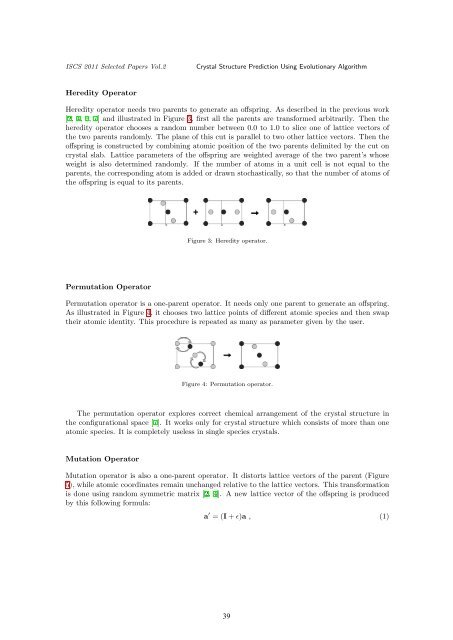RECENT DEVELOPMENT IN COMPUTATIONAL SCIENCE
RECENT DEVELOPMENT IN COMPUTATIONAL SCIENCE
RECENT DEVELOPMENT IN COMPUTATIONAL SCIENCE
You also want an ePaper? Increase the reach of your titles
YUMPU automatically turns print PDFs into web optimized ePapers that Google loves.
ISCS 2011 Selected Papers Vol.2 Crystal Structure Prediction Using Evolutionary Algorithm<br />
Heredity Operator<br />
Heredity operator needs two parents to generate an offspring. As described in the previous work<br />
[2, 4, 6, 7] and illustrated in Figure 3, first all the parents are transformed arbitrarily. Then the<br />
heredity operator chooses a random number between 0.0 to 1.0 to slice one of lattice vectors of<br />
the two parents randomly. The plane of this cut is parallel to two other lattice vectors. Then the<br />
offspring is constructed by combining atomic position of the two parents delimited by the cut on<br />
crystal slab. Lattice parameters of the offspring are weighted average of the two parent’s whose<br />
weight is also determined randomly. If the number of atoms in a unit cell is not equal to the<br />
parents, the corresponding atom is added or drawn stochastically, so that the number of atoms of<br />
the offspring is equal to its parents.<br />
Permutation Operator<br />
Figure 3: Heredity operator.<br />
Permutation operator is a one-parent operator. It needs only one parent to generate an offspring.<br />
As illustrated in Figure 4, it chooses two lattice points of different atomic species and then swap<br />
their atomic identity. This procedure is repeated as many as parameter given by the user.<br />
Figure 4: Permutation operator.<br />
The permutation operator explores correct chemical arrangement of the crystal structure in<br />
the configurational space [7]. It works only for crystal structure which consists of more than one<br />
atomic species. It is completely useless in single species crystals.<br />
Mutation Operator<br />
Mutation operator is also a one-parent operator. It distorts lattice vectors of the parent (Figure<br />
5), while atomic coordinates remain unchanged relative to the lattice vectors. This transformation<br />
is done using random symmetric matrix [2, 4]. A new lattice vector of the offspring is produced<br />
by this following formula:<br />
a ′ = (I + ɛ)a , (1)<br />
39


